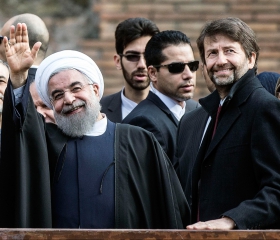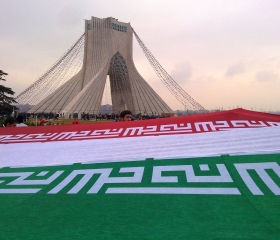The emergence of new political formats is usually accompanied by mistrust of the critically minded expert community. However, the emergence of the Russia-Azerbaijan–Iran bloc spanning the western coast of the Caspian Sea could become a powerful impetus for the interpenetration of the three countries’ economies and for institutionalizing political dialog. Are the summit participants themselves interested in such a development, and if so, then under what conditions?
On August 8, 2016 in Baku, the first trilateral meeting of the Presidents of Russia, Azerbaijan, and Iran was held. The Caspian states have several things in common: their economies greatly depend on exporting hydrocarbons, they fight a high inflation, and also these countries are attempting to transform the Middle East and the Caspian region in accordance with their own vision. Despite these similarities, the countries approached the summit with different goals and in different moods. Russia is gradually getting used to life “after Crimea,” as it continues to withstand the international political pressure; Azerbaijan apparently found itself in the situation Russia was in 2015, while Iran does everything within its power to get economic reforms in the country going, as it is wary of possible growth of inflation and unemployment. The summit took place on the eve of President Vladimir Putin’s meeting with President Recep Erdogan, and therefore, the meeting could not but produce a great excitement, yet its consequences could be far-reaching for the entire Caspian region.
Russia has been under sanctions for more than two years already. Despite some successes (for instance, the agricultural sector is showing stable growth, in 2016, Russia became the world’s leading wheat exporter), Russia’s economy is suffering from not being fully included in the global economy, since leading Russian companies are forbidden to enter western countries’ long-term credit markets. The recession of the last two years and the ruble falling by 60% had a ripple effect on Azerbaijan: according to the IMF, a 1% drop in Russia’s GDP results in the 0.4% drop in the GDP of oil exporting Caspian countries. After oil prices stabilized above $40 per barrel, the first signs of a renewing growth appeared, and the experts predict the end of recession in the 3rd-4th quarters of 2016. Due to a lack of serious structural reforms in Russia, its leadership is ready to look closely at the ambitious projects outside Russia, at its southern borders.
Azerbaijan’s economic situation was negatively affected by the dropping oil prices and by the Russian economic recession. Azerbaijan had to devalue the manat, its national currency, twice: by 30% in February and by 50% in December 2015. For the first time over the last 20 years, the country runs a trade deficit; in January-June 2016, it was 226 million dollars. Over that period, the country’s GDP decreased by 3.4%, and several international financial institutions (the IMF, Standard&Poor’s, Fitch) expect Azerbaijan’s economy to become only negligibly stronger, with the GDP drop stabilizing at 3%. Given that during the period of the explosive growth in oil prices in 2005-2008, Azerbaijan’s GDP grew on average by 24% and the country did not face recession even in the following years, the rapid economic drop caught many people unawares.
In its turn, Iran is on the upswing after settling the nuclear problem and moderate political forces winning the parliamentary elections in February 2016. The economic growth outpaces the general global growth: it is predicted that in 2016, the GDP will grow by 4.2%, and in 2017, the indicator will increase to 4.6%. It is largely due to the fact that Iran can now freely trade in its leading export commodity, the hydrocarbons, yet due to its fairly strongly diversified economy, the country’s GDP grew in 2014-2015, when Iran was under sanctions. Iran has major ambitions; Mr. Rouhani’s government intends to achieve an 8% GDP growth, yet it will require major investments: about $150 bn in Iran’s authorities’ estimates. Iran needs investments and a profound involvement in the global economic processes, and the Caspian summit in Baku is a good opportunity to strengthen its relations with Azerbaijan and, to an even greater extent, with Russia.
To unite the Caspian region...
The meeting’s format is quite similar to one of the energy summits of the Caspian states’ leaders; the latest summit took place in September 2014 in Astrakhan, the next one will take place in 2017 in Astana. However, besides the different list of participants (the Baku meeting did not include Kazakhstan and Turkmenistan), the new format has a broader range of issues under discussion. Transportation, trade regimes, economy, global security: all these issues were discussed and will be discussed at a new round of meetings (the participants have already stated their interest in continuing with this format).
Lifting the Iranian sanctions gave Russia an opportunity to promote the inclusion of Iran in the integration associations within the Eurasian space. First, the Kremlin spoke in favor of Iran joining the SCO; currently, Mr. Putin proposed creating a Free trade zone between the Eurasian Economic Union and Iran. A more vigorous international economic activity became one of the principal slogans in the Russian-Azerbaijani talks, since the trade turnover between the two countries dropped in January-June 2016. Russia’s and Azerbaijan’s trade relations with Iran are, on the contrary, on the upswing after the lifting of sanctions: it is predicted that the trade turnover between Iran and Azerbaijan will grow by 80% in 2016, and the Russian-Iranian trade turnover will grow by 60-70%.
It should be noted that while the leaders discussed the economic initiatives at bilateral meetings there were no comprehensive suggestions besides formally calling upon the parties to stimulate cooperating in trade and economy. Apparently, Iran’s bets are on involving Russian energy companies into projects in Iran, while in its relations with Azerbaijan, Tehran intends to develop transportation infrastructure as well as the industrial and banking sectors.
As Sh. Mustafayev, Azerbaijan’s Minister of Economy, said the total amount of Iran’s investments into Azerbaijan’s economy’s is 1.5 billion dollars. In future this number is going to grow. Among others, the summit saw the agreement between Iran’s automaker Iran Khodro and Azerbaijan’s AzEuroCar company on manufacturing Iranian car models confirmed on the top level. Currently, there are 450 companies with Iranian capital in Azerbaijan, largely because there are no serious political differences between the two states and there is a big Azerbaijani diaspora in Iran.
The possibility of constructing the North-South transportation route was the subject of a lively discussion at the summit; in the future, this route could become the Suez Canal’s direct competitor. The North-South project was first mentioned in September 2000, when Russia, Iran, and India signed an agreement on connecting St. Petersburg and Mumbai via a transcontinental transportation corridor. The RZD’s interest is clear, almost half of the land corridor passes through Russia’s territory, but Azerbaijan and Iran are also interested in cargo transit. The entire Astara – Qazvin route connecting Azerbaijan and Iran should be completed by 2019, which will produce a full-scale transit route along the entire western coast of the Caspian Sea. Within the North-South transportation corridor, the trans-Caspian trade will receive a new impetus due to expanding the Caspian Sea ports’ capacities, including the Astrakhan port, and also due to the Russian ports of Olya and the Iranian port of Neka being put to a more active use.
… and then to divide it up…
Despite the expanded agenda of the meeting between the heads of Russia, Azerbaijan, and Iran, energy could not help playing an important part in the discussions. The energy issue in the Caspian region is inextricably linked with politics. The main stumbling block is the distribution of the Caspian Sea’s hydrocarbon resources and dividing up the sea between the five coastal countries. During the four previous Caspian summits which had been held 3-4 years apart, the heads of state failed to achieve a comprehensive agreement on the most crucial issues. During the 2014 Astrakhan Summit, the Conventions on hydrometeorology, on the natural disaster alerts, on preservation and rational use of marine biological resources were signed, but no breakthrough in dividing up the Caspian Sea was achieved.
Iran believes that the Caspian Sea should be divided up into equal shares (20% of the sea shelf to each party) between Russia, Azerbaijan, Iran, Turkmenistan, and Kazakhstan. In 2003, Russia and Azerbaijan signed an agreement on the delimitation of the contiguous parts of the Caspian Sea floor, and they insist on dividing the sea up in accordance with the coastline length. At the same time, Azerbaijan is doing its best to promote the idea of constructing a trans-Caspian gas pipeline which could carry Turkmenistan’s gas through Azerbaijan’s territory into Europe, but Russia and Iran are against this plan. The stakes are exceedingly high, since the deep-water and subsalt deposits of the Caspian Sea are virtually unexplored, and no country wants to lose potential deposits because of a single unfortunate political step.
Apparently, in the nearest future, the initiatives on determining the legal status of the Caspian Sea will produce no tangible results. This pessimistic prediction is based, among other things, on the fact that thus far, there is still no clear understanding of whether the Caspian Sea is, indeed, a sea. This is a significant matter, since if it is declared to be a lake, the notion of a sea shelf will have no place there. On the other hand, if the Caspian Sea is declared to be a sea sui generis, it will take more than one decade to delimitate the jurisdictions within a convention that would be both comprehensive and more or less acceptable to everyone.
In Baku, Ministers of Energy discussed a series of other issues, including a remarkable gas project: setting up swap gas shipments with Iran. The proposed plan would entail Gazprom supplying gas to Iran’s northern regions where there are no significant deposits. In exchange, the Russian company, either in cooperation with Iran or independently, would receive liquefied natural gas (LNG) in the south of Iran, with the LNG subsequently being sold on Asian markets, the capacious Indian market being not the least of them. This project was discussed along with possible oil projects which can be implemented now that the sanctions have been lifted. Several Russian companies declared their interest in projects in Iran, among them Rosneft, LUKOIL, Gazprom Neft, Zarubezhneft.
The project of constructing two new power units of the Bushehr Nuclear Power Plant (the so-called Bushehr-2) takes on its final shape. New units will be built using Russian technologies, nuclear fuel will be supplied by Russia, and nuclear waste will be taken back to be recycled. Alexander Novak, Minister of Energy, stated that the construction of two new units could begin even in 2016. The Bushehr NPP, whose first unit was completed only in 2011 after 36 years of trials and tribulations due to sanctions, will contribute to diversifying Iran’s energy sources, since currently, 92% of the country’s electric power comes from oil and gas. In its turn, Rosatom will improve its positions in the markets of the developing economies.
…and make it secure
The Caspian region security could also become a regular part of the agenda at the Russian-Azerbaijani-Iranian summits. Same as economy, it is discussed mostly at bilateral meetings, and only standard diplomatic formulas are being brought to the table at the joint trilateral format. In the Russian-Azerbaijani talks, particular emphasis was made on Nagorno-Karabakh. The talks in Baku became a continuation of the June summit of the Presidents of Russia, Armenia, and Azerbaijan in St. Petersburg; that was a breaking point on the path toward normalizing the situation in the region and minimizing the military hostilities. Given that on August 10, 2016, Vladimir Putin, President of Russia, met with Serzh Sargsyan, President of Armenia, it should be stated that the OSCE Minsk Group was essentially replaced with the Kremlin’s personal diplomacy.
Russian-Iranian talks focused primarily on fighting ISIS in Syria. As Syria’s government army with a powerful support from Russia’s aerospace forces attempt to encircle Aleppo tighter and tighter, Moscow and Tehran once again compared notes. Iran also takes a very active part in the Syrian conflict. It lost over 1,000 troops from the Army of the Guardians of the Islamic Revolution, it spent, as S. de Mistura cliams, about $6 bn annually to support the Syrian regime, and now Tehran is not ready to put up with any kind of ISIS presence near its borders.
On the whole, Russian – Azerbaijani – Iranian summits have significant prospects. For decades, the region’s energy will be the main criteria of the energy security in Europe and possibly in South Asia. The North-South project could in the future become the Suez Canal’s competitor on the land, especially if the comparable volumes of cargo will be transported in both directions. The unexplored potential lies in liberalizing the trade in services, in harmonizing external economic regimes and tariffs, regulations and standards, intellectual property rights. The most important thing is for the political will to strengthen the Caspian cooperation trend to remain steadfast and unflagging.







